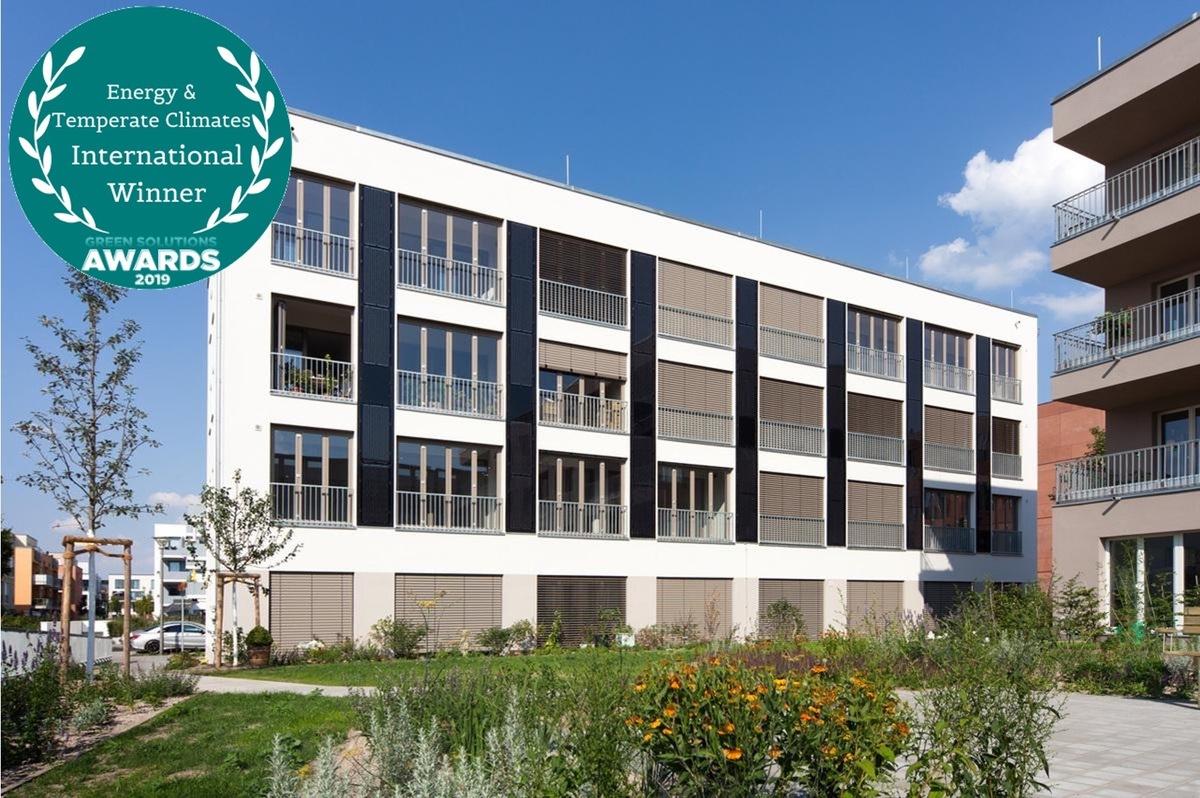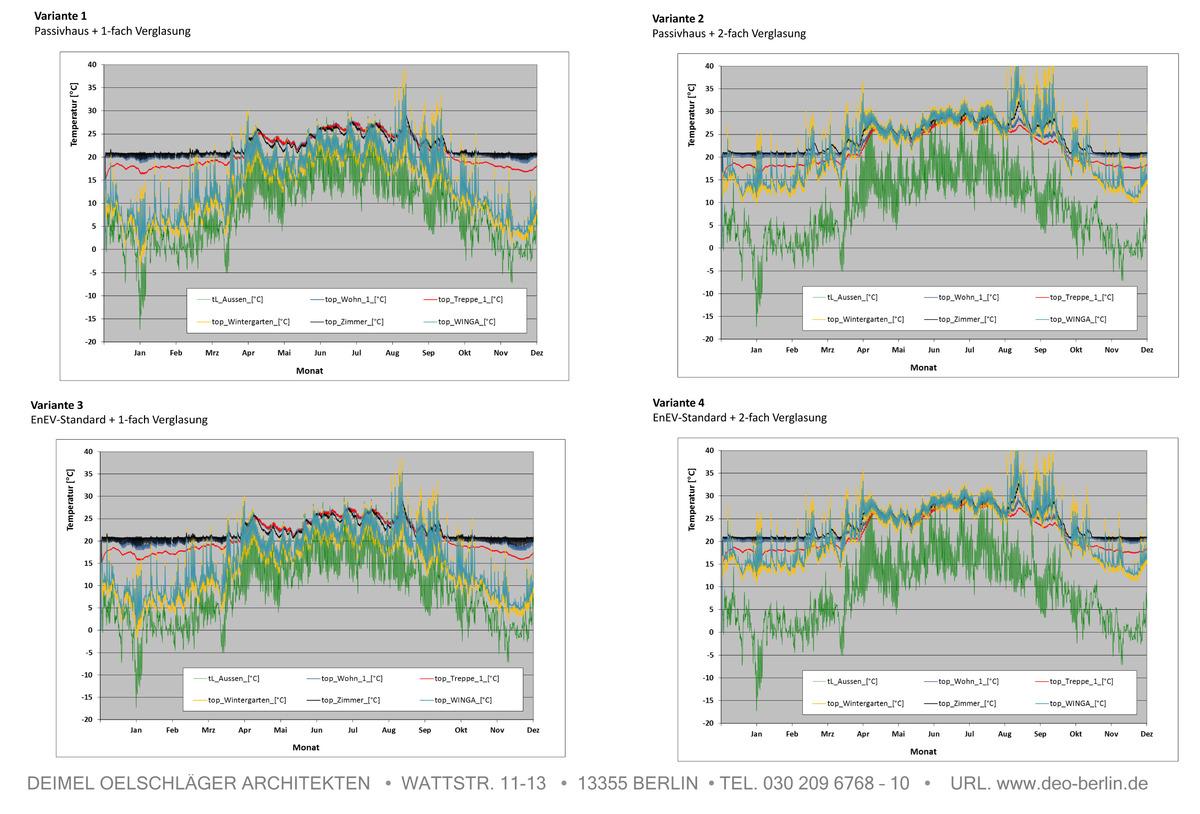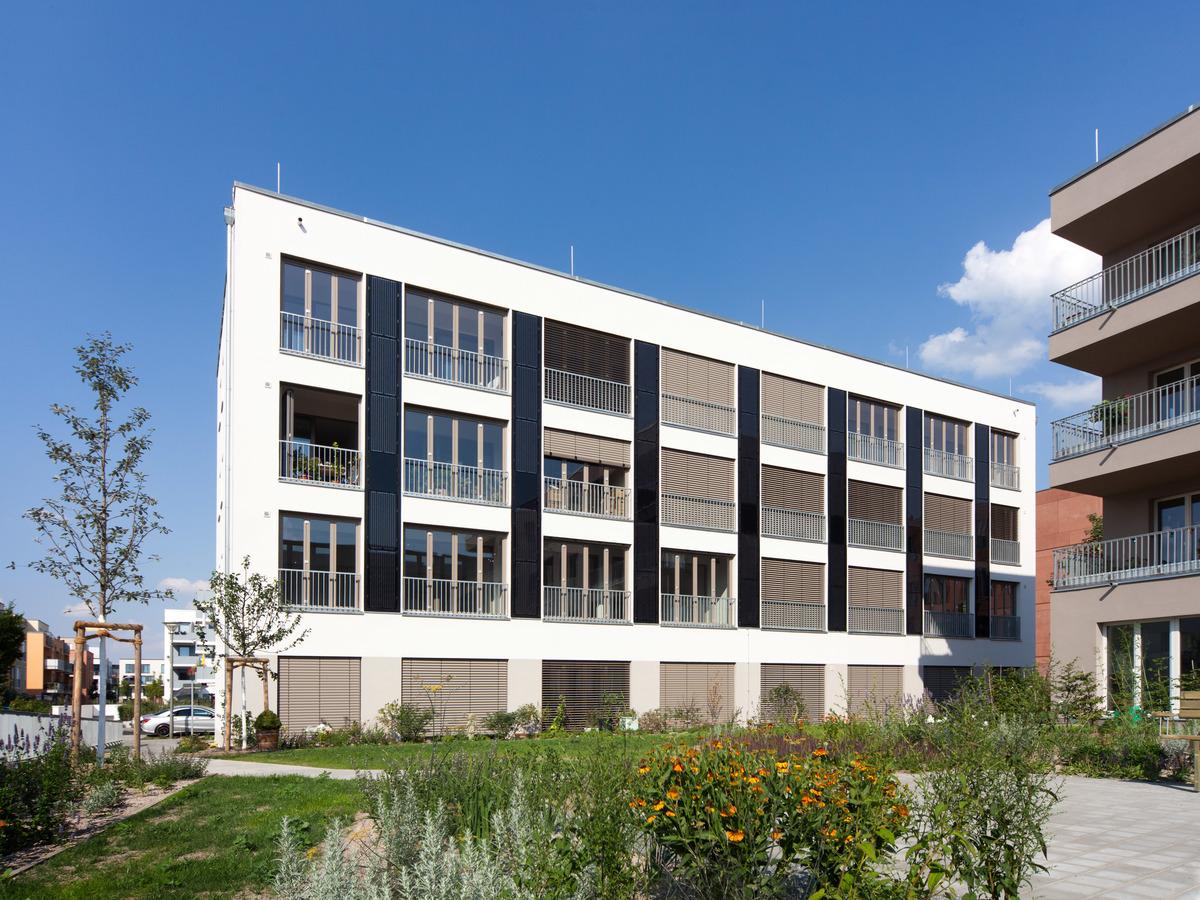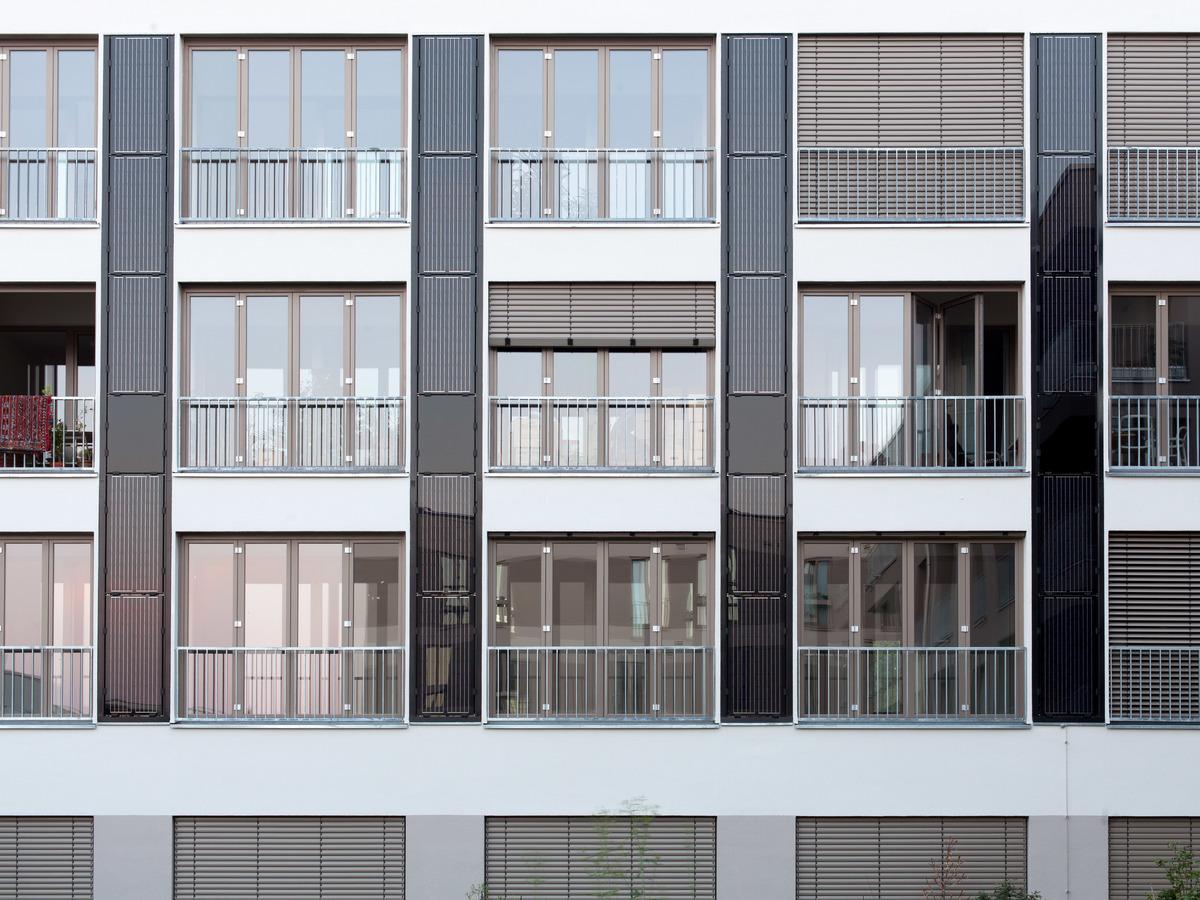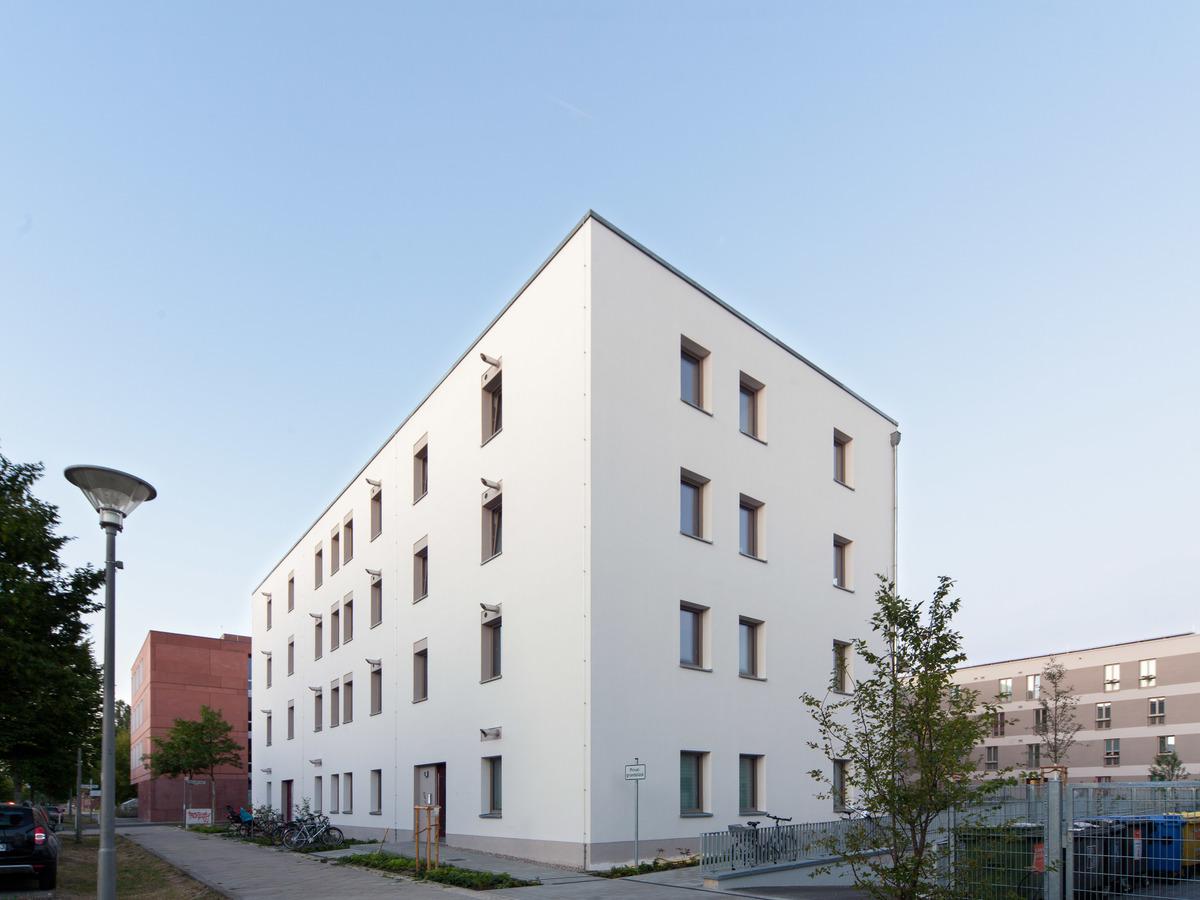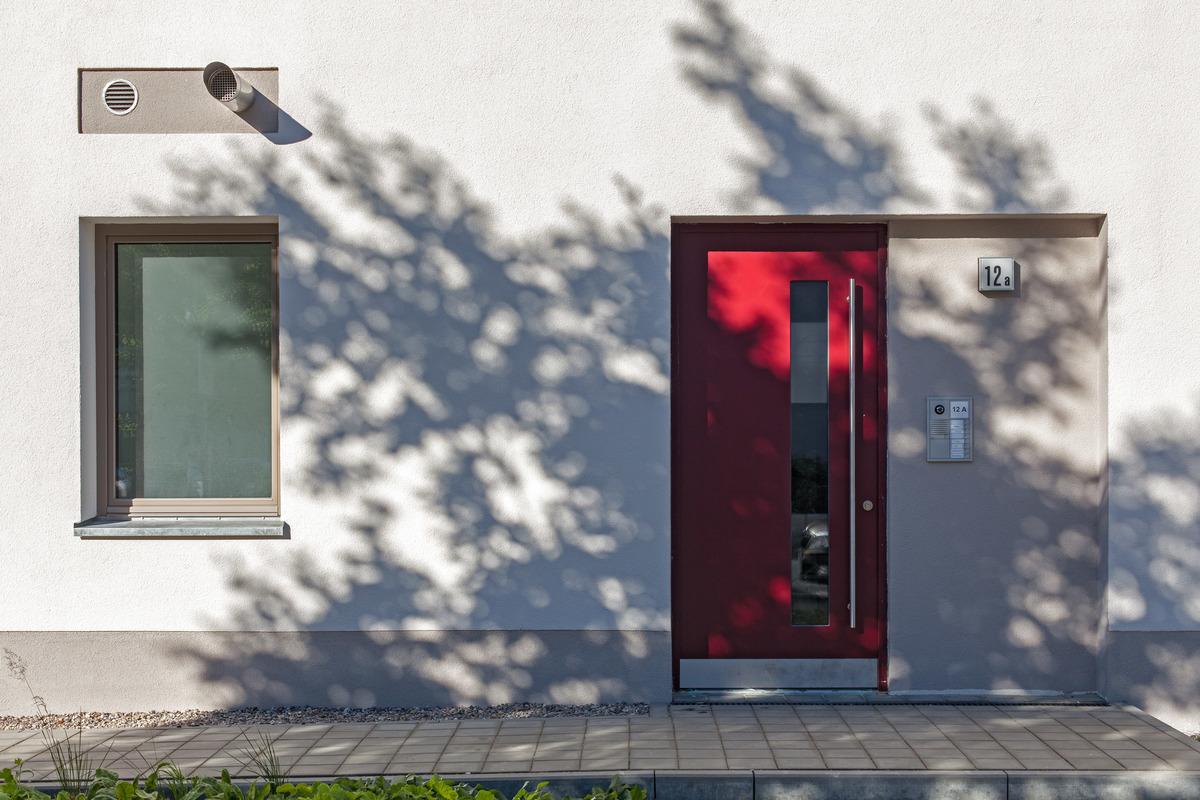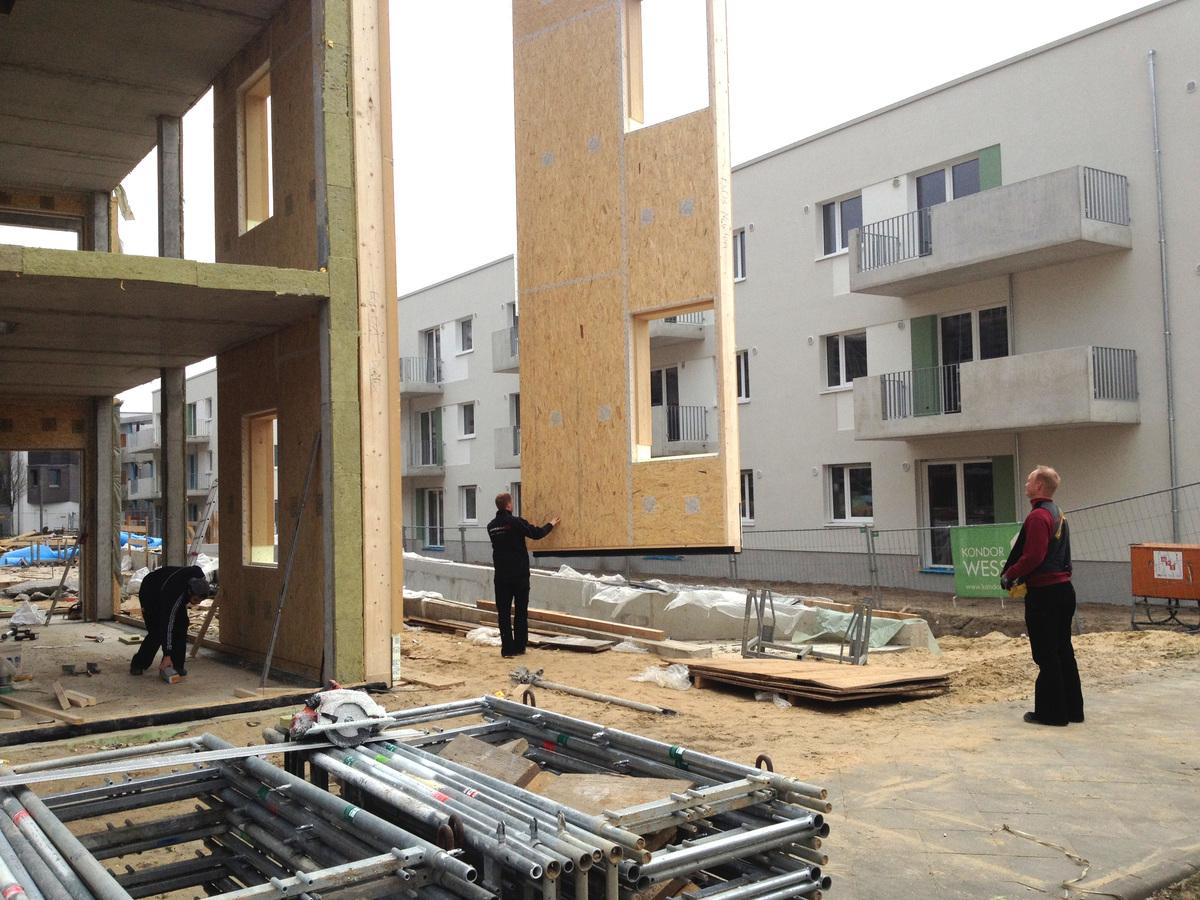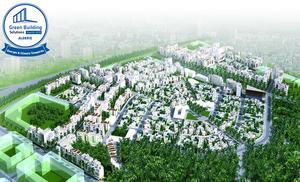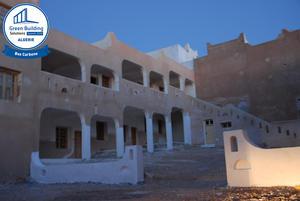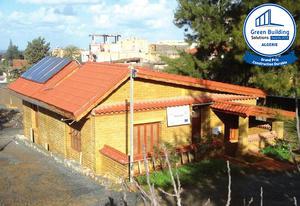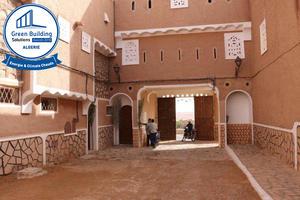NEWTONPROJEKT Haus 1, Berlin Adlershof
Last modified by the author on 11/05/2020 - 16:09
New Construction
- Building Type : Collective housing < 50m
- Construction Year : 2018
- Delivery year : 2018
- Address 1 - street : Abram-Joffe-Straße 10,12 12489 BERLIN, Deutschland
- Climate zone : [Dfb] Humid Continental Mild Summer, Wet All Year
- Net Floor Area : 1 085 m2
- Construction/refurbishment cost : 2 065 830 €
- Number of Dwelling : 13 Dwelling
- Cost/m2 : 1903.99 €/m2
-
Primary energy need
6.68 kWhpe/m2.year
(Calculation method : )
NEWTONPROJEKT won the Energy & Temperate Climates Prize of the 2019 Green Solutions Awards at the Germany level + the international Energy & Temperate Climates Prize.
The project was conceived as a flagship project for innovative sustainable district development with an assembly and a joint plus energy concept in wood construction.
The three buildings have a significant reduction in CO2 emissions due to their high-quality passive house construction and their energy concept. It is assumed that the KfW Efficiency House 40 Plus standard will be surpassed in practice and a negative annual energy demand will be achieved. This means that the houses generate more energy than the inhabitants consume.
House 1 completes the settlement to the north. It consists of 13 plugged apartments between 50m2 and 150m2. To the street in the northeast are stairwells and adjoining rooms. In the southwest, to the courtyard side, there are the lounges and upstream conservatory. Flexibility in floor plan design was especially considered in the design process.
The mixed construction of solid reinforced concrete core and curtain-mounted wooden façade makes it possible to reduce the thickness of façades with high insulation requirements. The wooden windows have a triple glazing. The materials used on the façade are eco-friendly made of wood, the insulation made of cellulose and recyclable wood soft fiber.
Awards
- KlimaSchutzPartner des Jahres 2015 in the category "promising and innovative plans"
- EnEff "Gebäude.2050" 1st prize in the category "Ideas for trendsetting buildings and quarters"
Data reliability
Self-declared
Photo credit
Andrea Kroth
Contractor
Construction Manager
Stakeholders
Structures calculist
Lichtenau Himburg Tebarth Bauingenieure GmbH
Bismarckstraße 78 10627 Berlin, [email protected]
http://lht-bauing.de/Structural design and building physics
Thermal consultancy agency
pi Passau Ingenieure GmbH
Geysostr. 19 38106 Braunschweig , [email protected]
http://www.passau-gmbh.de/Haustechnikplanung
Others
Dr. Ing. Gabriele Holst
Agricolastraße 3 10555 Berlin , [email protected]
http://www.gestaltungfreiraum.de/landscape architect
Others
Büro 1.0
Schwedter Str. 263, 10119 Berlin
https://www.buero-1-0.de/project management
Others
Low-E Ingenieurgesellschaft für energieeffiziente Gebäude
Prof. Dr.-Ing. Lars Kühl Am Exer 10, 38302 Wolfenbüttel
https://low-e-ingenieure.de/energy consulting
Contracting method
Off-plan
Owner approach of sustainability
- As a construction community NEWTONPROJEKT GbR, we realize the three multi-family houses in passive house standard with plus energy since May 2016 as a multi-generational community. Floor plans were flexible and customizable in the planning phase. As builders, we make all decisions democratically. Our project fits well into the emerging new residential district of the city of science Adlershof with many companies related to energy. Through our members we maintain professional, family and other connections in the city of science and the surrounding area.
- With our concept of feeding solar heat as storage into the Adlershof district heating network and, if necessary, taking it back there, we are combining in an innovative way with the infrastructure and jointly shaping the climate-friendly energy future Garden and community are very important to us. The three residential buildings are grouped around a courtyard garden, which can be shared by all residents. All rainwater is discharged into the surface under a combination of superficial infiltration and trenches.
- Adlershof Projekt GmbH plans to extend this plus energy concept to other future construction phases on the site in Adlershof. Housing is currently booming and many locations are being reopened. In the development of new urban neighborhoods and locations, there is an opportunity to build decentralized, energy-generating neighborhoods through integrated development already in the development and planning phase, to optimize self-consumption through integrated storage systems for electricity and heat, and to existing or new heating grids and facilities to use. In addition, the Newton project provides valuable preliminary work, which will be published with scientific evaluations ( DBU project, BMWi research ), implemented in real terms and can serve as an example .
Architectural description
- Floor plan
- The house 1 in the Newton project consists of 13 apartments between 50m2 and 150m2 living space. The floor plans were planned as plugged apartments. To the side of the road in the northeast, the side rooms and staircases are designed. In the southwest to the courtyard side each apartment receives an unheated conservatory. Flexibility in floor plan design was especially considered in the design process. With the aid of a switch room, the floor plans could be reduced or enlarged and small apartments could be joined together to form a large family apartment. Thus, the development of individual solutions according to the needs of the builders has been made possible.
- Innovative facade system
- An important point that brings a special public perception of the project, is the facade with a PV system. Great importance was attached to the creative integration of the PV modules in the building facades. Thanks to their flat substructure, the PV modules on the south façades could be integrated flush with the cleaned surface. In addition to the development of the technical basics in the planning, the challenge lay in the implementation of the PV system on a wooden facade in coordination with fire protection, building services and contractors as well as the technical optimization of the PV system and the selection of storage for the selected energy management system of the building complex.
- Awards
- - KlimaSchutzPartner des Jahres 2015 in the category "promising and innovative plans"
- - EnEff "Gebäude.2050" 1st prize in the category "Ideas for trendsetting buildings and quarters"
Energy consumption
- 6,68 kWhpe/m2.year
- 62,08 kWhpe/m2.year
- 42,00 kWhfe/m2.year
Envelope performance
- 5 133,00
- 0,60
Systems
- Urban network
- Combined Heat and Power
- Aerotherm Heater
- Solar thermal
- Urban network
- Solar Thermal
- No cooling system
- Nocturnal Over ventilation
- Double flow heat exchanger
- Solar photovoltaic
- Solar Thermal
- Other, specify
- 85,00 %
GHG emissions
- 2,87 KgCO2/m2/year
Life Cycle Analysis
Water management
Indoor Air quality
Comfort
Product
The PV modules asola VITRUM®
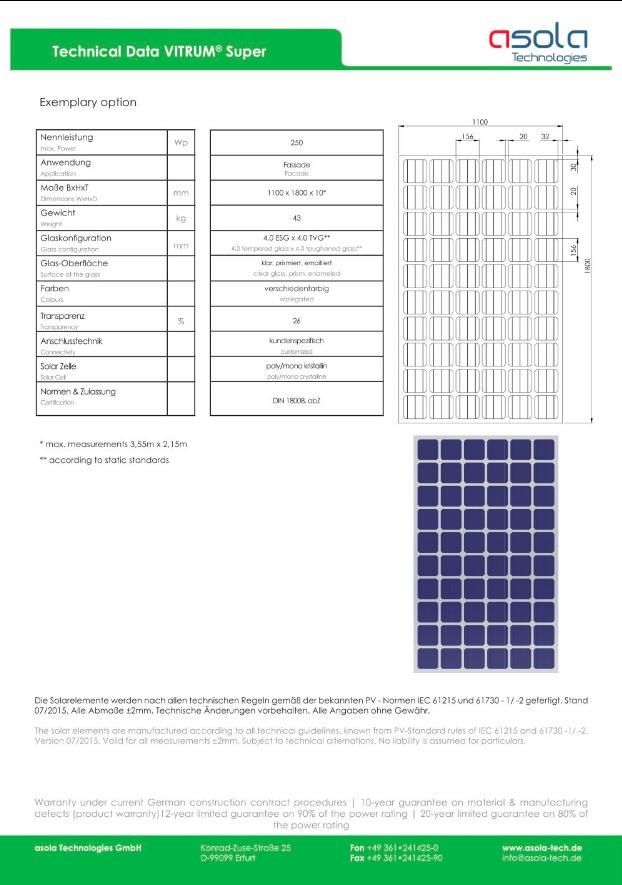
asola Technologies GmbH
https://www.solarcarporte.de/asola-technologies-gmbh
asola manufactures the solar composite glass element "asola VITRUM Super" both in standard sizes and for custom applications according to the "Technical Guidelines for the Use of Suspended Glazing" (TRLV and TRPV). Depending on the type of façade, façade grid and building height, solar laminated glass elements can be integrated as cold façades or as warm façades in both existing and new buildings.
Solar cell technology: Monocrystalline
Rated power PMPP: 150 Wp
Module efficiency at STC: 13.9%
Rated voltage UMPP: 19.80 V
Energy concept LoW-E
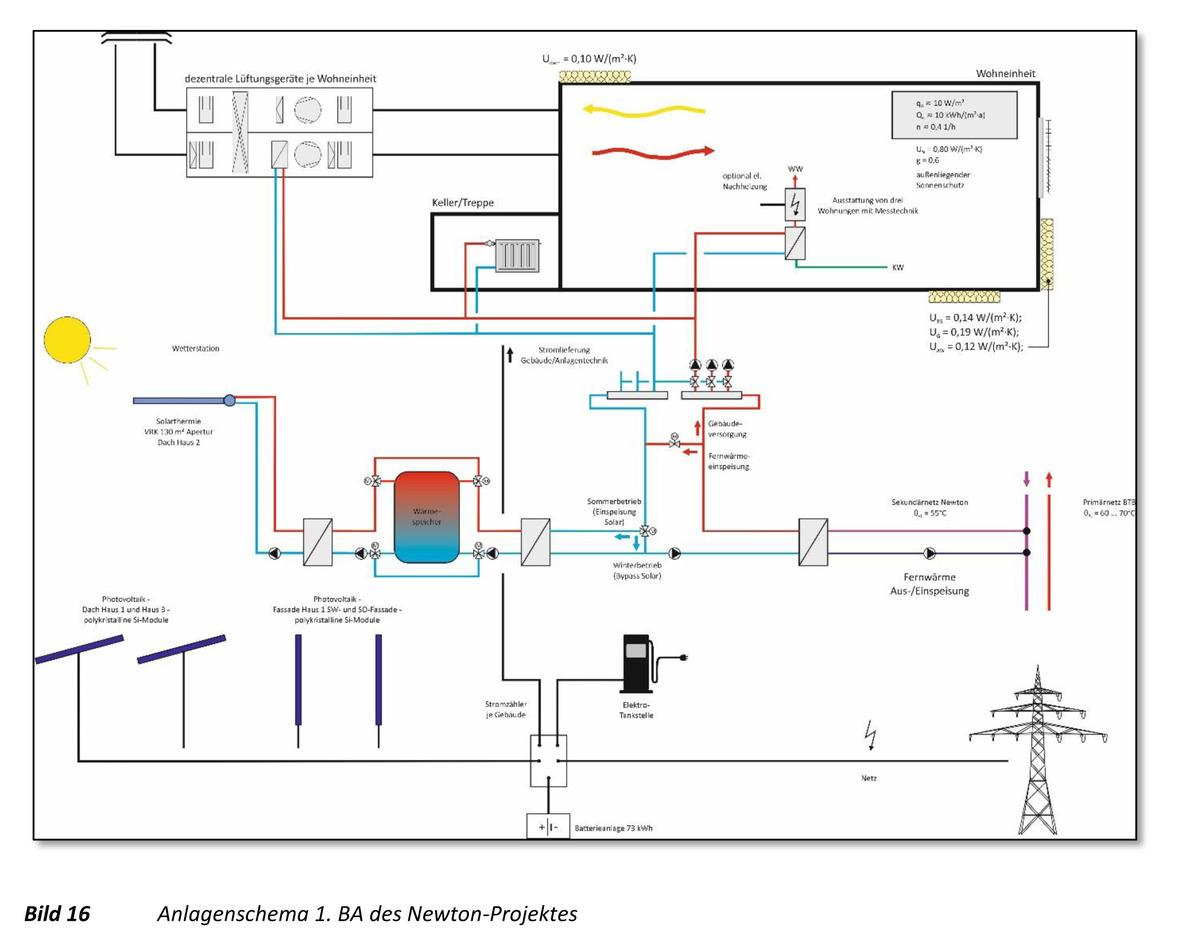
Low-E Ingenieurgesellschaft für energieeffiziente Gebäude
Prof. Dr.-Ing. Lars Kühl, Am Exer 10, 38302 Wolfenbüttel
https://low-e-ingenieure.de/
Low-E engineering company was involved in the project from the beginning as part of the integrative planning process.
As part of the planning phase, various approaches to care were developed and compared with one another. In addition to centralized solutions, decentralized solutions should also be considered. By integrating all those involved in planning, as well as the client and the user, all the levels of requirements for the execution and operation of the buildings are to be included in the planning.
As part of the concept development for the energy supply of the "Solar Plus Energy" development in Berlin Adlershof, a total of 6 different variants with regard to the provision of heat and electricity are being examined in the preliminary planning phase. The passive house standard of the buildings with the corresponding U-values and a maximum annual heating requirement of 15 kWh / (m²a) is set in all variants.
Further simulation tools were used for the development of control strategies as well as for the investigation of room concepts, climate buffers and different temperature zones within a dwelling.
LTS aeration and deaeration device TSL-150
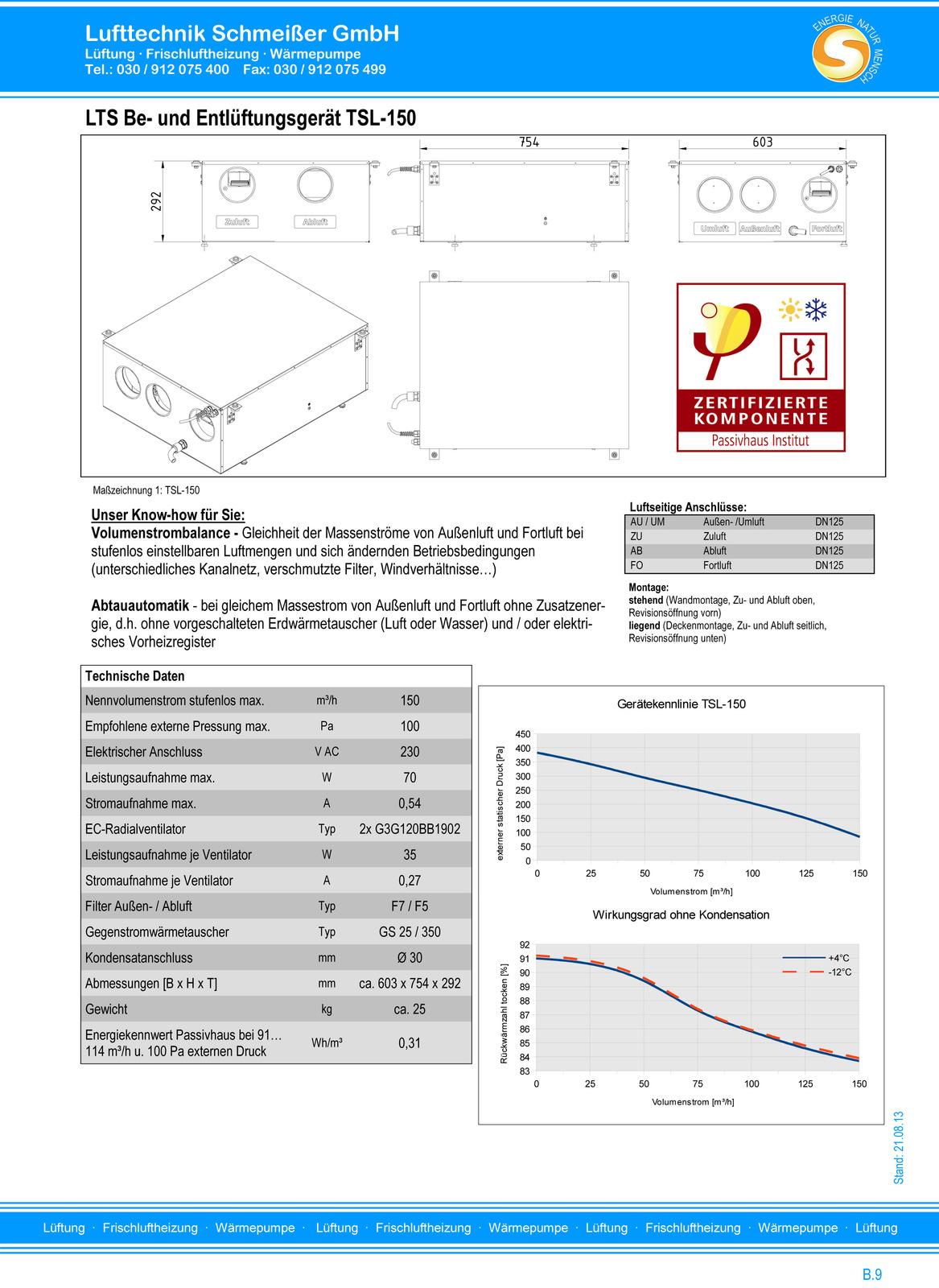
Lufttechnik Schmeißer GmbH
http://www.lufttechnik-schmeisser.de/
Suitable for a nominal flow rate of 50-130m³ / h, the TSL-150 air handling unit offers a space-saving solution for housing as well as smaller family homes. The device is designed as a wall & ceiling device and disappears thanks to its size, in every small technical room.
Wooden facade with integrated PV modules
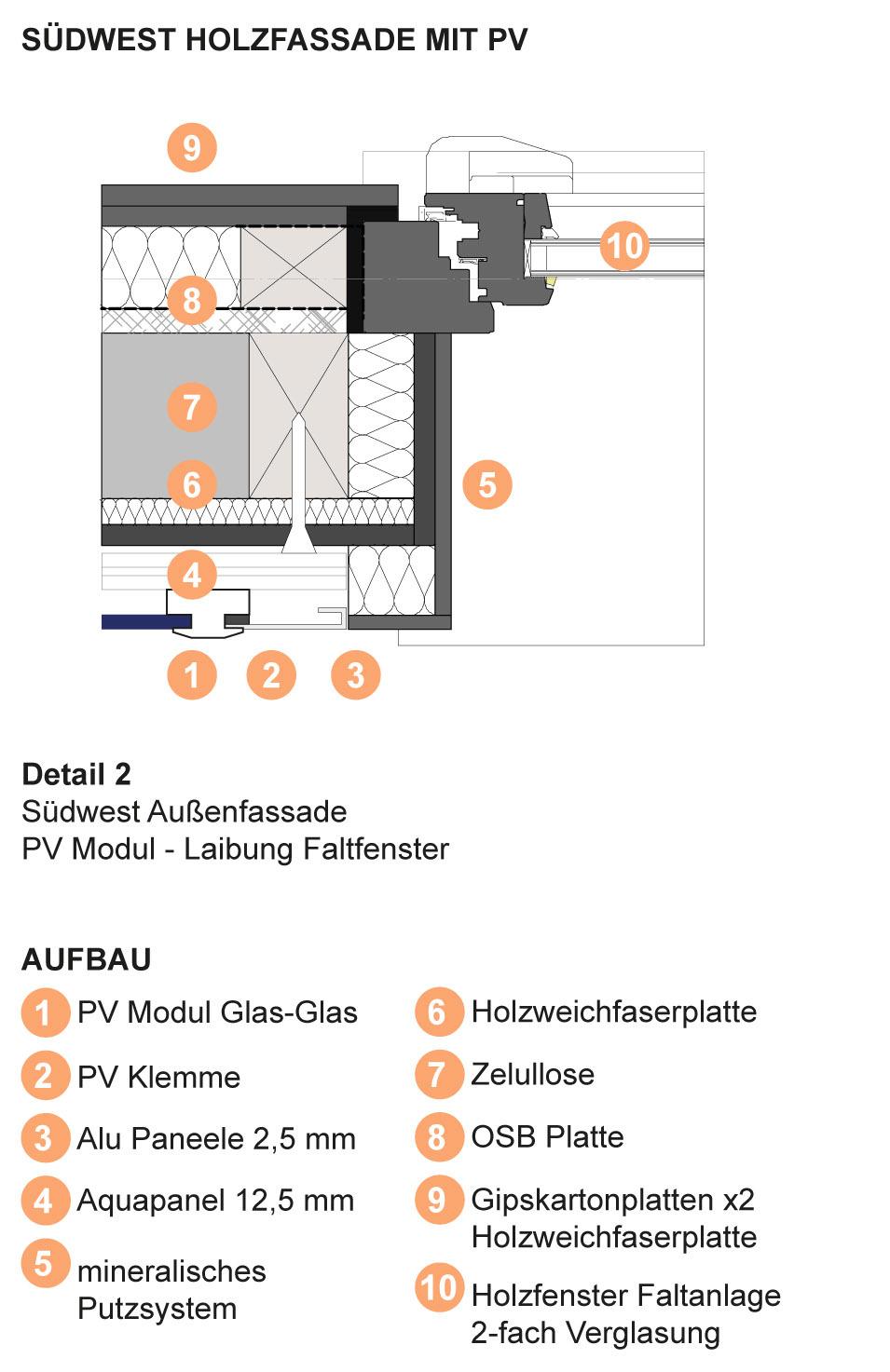
Deimel Oelschläger Architekten Partnerschaft
http://www.deo-berlin.de
In the southwest and southeast façade the wall construction was reduced to include the PV modules. In order to meet the technical and fire safety requirements, an external cement board was installed. The technical basis was developed by means of an expert opinion.
Great emphasis was placed on the creative integration of the PV modules in the building facades.
The PV modules form a level with the cleaned surface and are largely integrated in the façade level.
Winter garden as a climate buffer

Deimel Oelschläger Architekten und Low-E Ingenieurgesellschaft für energieeffiziente Gebäude
http://www.deo-berlin.de
The winter gardens are being developed as so-called "additional rooms". Due to the solar radiation and the outflow of heat from the building, it is assumed that the rooms are frost-free even during the winter period and can therefore be used most of the year. Energetically, they can be considered as buffer spaces. The thermal behavior and the resulting operating room temperatures are investigated by a thermal simulation.
In particular, the influence of conservatories on the annual heating demand is the subject of the investigation. In terms of construction, the conservatories should be designed with 2-fold WSV glazing with a U-value of 1.1 W / (m²K).
This version as a double EnEV façade is the result of a study on the cost optimization of the facades in relation to the requirement for frost-free and energy buffer. The conservatories should be run unheated.
Research project "High Tech Low-EEx Energy Efficiency Berlin Adlershof 2020"
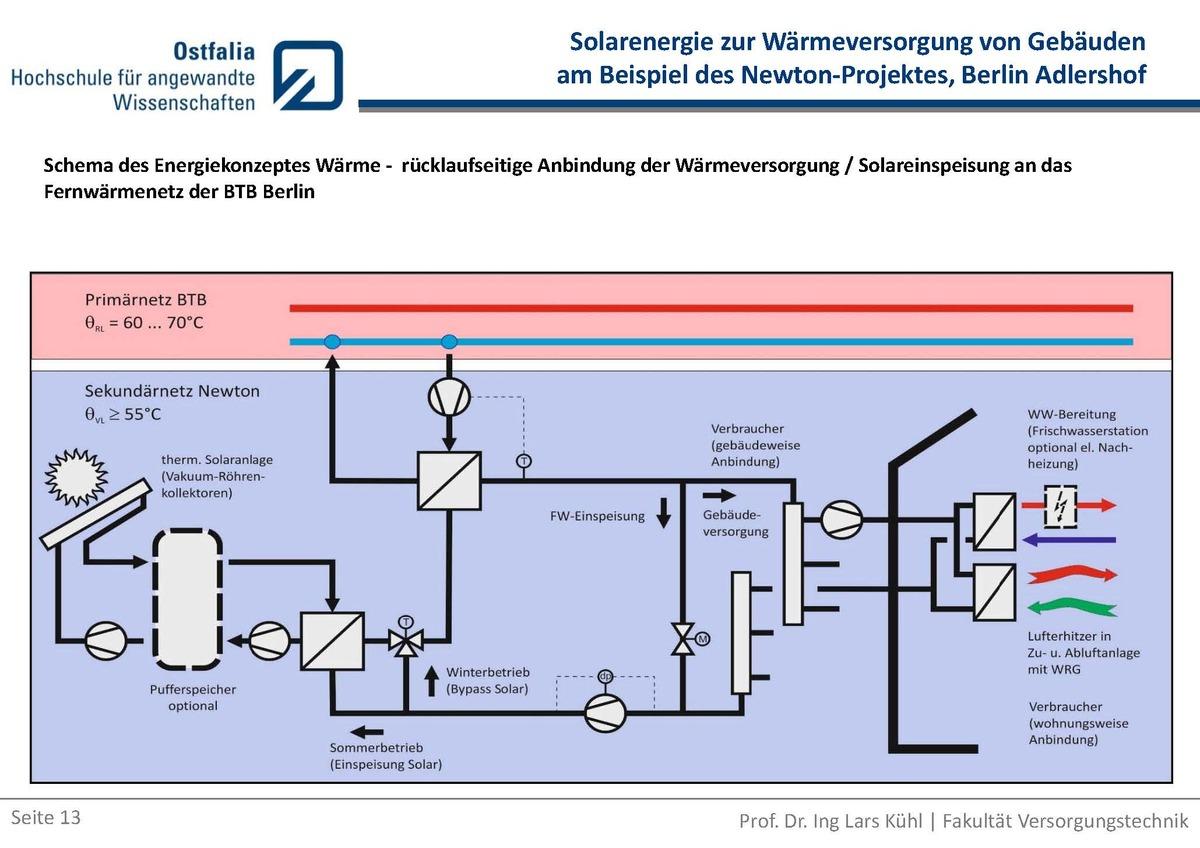
BTB Berlin und TU Dresden
clemens.felsmann@tu-dresden.de
https://tu-dresden.de/
Three investors are currently involved in the innovative "Living on Campus" pilot project: two large Berlin housing associations and one subassembly. All have installed solar thermal systems on the roofs of their buildings. The quarter is located not far away from the cogeneration plant Adlershof. The BTB's modern cogeneration plant is powered by natural gas and feeds the heat, which is generated by 90% in cogeneration, into a network that goes far beyond Adlershof, which also supplies the newly connected residential district.
The TU Dresden scientifically accompanies the pilot project "Niedertemperaturnetz" over two heating periods and evaluates the results.
Common research contents of the NEWTONPROJEKTS with the BTB are:
• Utilization of renewable energies via utility grids during off-peak hours
• Organization and operation of "intelligent house stations" for the storage and withdrawal of heat in the internal and public supply network.
• Development of strategies for the organization of dynamic heat extraction costs / feed-in tariffs as a function of temperature / exergy level and load level in the grid (summer / winter, outside temperature level) .Heat in the internal and public supply network
Construction and exploitation costs
- 129 690,00 €
- 2 832 513 €
Urban environment
With their coordinated facades and color concept, the three four-storey buildings form a uniformly designed ensemble in the new residential area in Adlershof. The shared green courtyard contributes to the improvement of the environmental microclimate and the partial facade and green roofs.
Land plot area
2 874,00 m2
Built-up area
40,80 %
Parking spaces
An underground car park with 17 parking spaces is equipped for electromobility. 110 bicycle parking spaces are located in the basement and in the yard.
Building Environmental Quality
- Building flexibility
- indoor air quality and health
- comfort (visual, olfactive, thermal)
- energy efficiency
- renewable energies
- building process
Reasons for participating in the competition(s)
ECOLOGICAL CONCEPT
✔ Fulfillment of the plus-energy standard , the planning of the building technology takes place under application of a KfW-Effizienzhaus 40 Plus standard and fulfills the Plus package. It is assumed that in practice, almost a negative annual final energy requirement is achieved.
✔ Reduction of CO2 emissions
✔ Implementation of renewable resources implemented in the building envelope.
✔ Use of a photovoltaic system and battery storage . The battery system allows the use of more than 50% electric current .
✔ The heat is supplied by the in-house solar thermal system . Surpluses are fed into the district heating network. ✔ Decentralized water heating to further reduce energy consumption.
✔ Rainwater infiltration. All rainwater is in a combination of superficial infiltration and trenches.
ECONOMIC CONCEPT
✔ Low operating costs due to the high and future-oriented construction quality of the project.
✔ Resource optimization in the planning phase. The facade elements could be carried out non-supporting due to the Schottenbauweise in order to reduce their overall strength.
✔ The future adaptability of the apartments was considered in the floor plan design.
Achitecture / DESIGN
✔ Development of individual solutions according to the needs of the clients.
✔ Innovative façade system through the integration of PV modules in the façade.
PROCESS QUALITY
✔ Integrative planning approach implemented together with builders, 3 architects' offices and specialist engineers and integrated into a research project of the DBU.
Building candidate in the category





